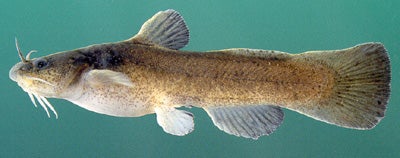SPECKLED MADTOM
SCIENTIFIC NAME: Noturus leptacanthus
CHARACTERISTICS: This slender, elongate species has small, distinct black spots scattered over the upper body and fins. The rounded anal fin contains 14 to 19 rays. The upper jaw protrudes slightly beyond the lower jaw. Pectoral spines are short and devoid of teeth. The back, sides, and fins are gray to medium brown with black spots. Chin barbels, underside of the head, and venter are white. See Jordan (1877a) for original description.
ADULT SIZE: 3.5 to 6 in (89 to 152 mm)
DISTRIBUTION: The widespread speckled madtom is possibly the most abundant madtom in Alabama. Like the black madtom, Noturus funebris, the Coastal Plain species avoids the alkaline water and physical stream conditions common to the Black Belt streams in the upper Tombigbee, Black Warrior, and Alabama river systems.
HABITAT AND BIOLOGY: Individuals occur around submerged vegetation, near leaf packs, and along the margins of small to large streams having slow to moderate currents and sand, silt, rock, and gravel substrates. Speckled madtoms spawn in June and July. Mettee et. al. (1987) observed spawning in Okatuppa Creek, a tributary to the lower Tombigbee drainage, in late June 1984. A male and female speckled madtom had deposited their spawn between the Masonite plates of a benthic invertebrate sampler. When the sampler was retrieved and disassembled, the male madtom and eggs were discovered. Madtoms often use crevices between rocks and logs as spawning sites.
REMARKS: The type locality for the speckled madtom is Silver Creek, a tributary to the Etowah River, Georgia.
ORIGINAL DESCRIPTION: The speckled madtom was described by Jordan in 1877.
ETYMOLOGY:
Noturus means back tail, referring to fusion of the adipose and caudal fins.
Leptacanthus means slender spine.
The copyrighted information above is from Fishes of Alabama and the Mobile Basin.






